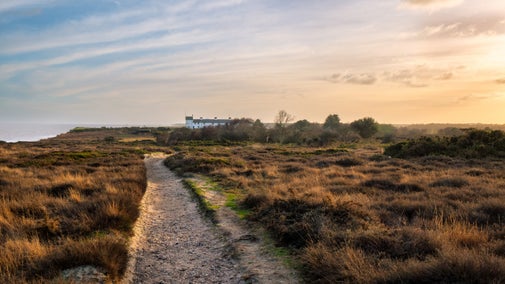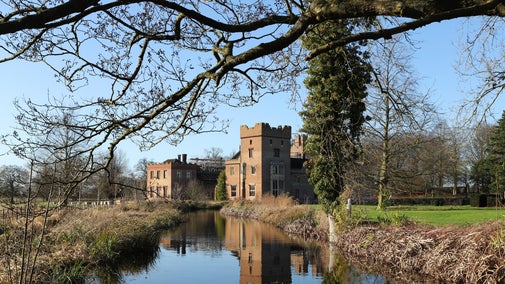
Find out more about Dunwich Heath
Find out how to get to Dunwich Heath, where to park, things to see and do, and more.

Dunwich Heath is a precious landscape with a wide variety of habitats, providing a home for a wealth of different species. Find out about the work we do to care for this traditional heathland.
Dunwich Heath has been in the care of the National Trust since 1968. In that time, we have restored the area to its traditional heathland and kept up regular maintenance of the various parts.
Further sections of land were added in 2002, with help from Pizza Express (which sold a seafood pizza to raise funds), the WREN land acquisition fund and our own coast fundraising campaign. This land now forms the acid grassland and heathland of Mount Pleasant Fields.
The soil that makes up the gently rolling slopes of the former Dunwich Common is mainly sand. This creates perfect conditions for the successful growth of heather, forming lowland heath. Lowland heath used to be prevalent across England, but in the last 120 years has declined by 92 per cent.
This makes Dunwich Heath one of the very few habitats of its kind left, and means that it can support the many rare wildlife and plant species that rely on this kind of ecology.
Several other smaller habitats have important roles to play in the ecology of Dunwich Heath. These include:
All these habitats make up the patchwork of Dunwich Heath. The land is further protected by the Suffolk Coasts and Heaths Area of Outstanding Natural Beauty (AONB), and is a Site of Special Scientific Interest (SSSI).

Despite being a hardy species, heather requires management to thrive. We cut it in such a way that there's a mosaic of varying ages across the site – this means that all the heather won't reach the end of its life in one go. In areas where there is young heather of a similar age and height, we cut it and leave it to regrow from the plants.
There are three types of heather at Dunwich: bell heather, cross-leaved heather and ling heather. The bell and cross-leaved heather are at their best in late July, whereas the ling heather is at its peak in early August. The purple-pink flowers are a delicate contrast to the tough, wiry stems that they grow on. In long, hot spells, the flowers can dry out, so aim to visit after recent rainfall.
In some parts of the UK, management of heathland is achieved through burning. We don’t do this, as the risk of fires getting out of control and destroying the entire heath is far too great. By cutting and scraping the heather, we create sun traps for reptiles and insects, and can use the cuttings and seedlings to encourage or restore new heath. We also share the cuttings with other organisations, such as the RSPB, and private owners.
Managing Mount Pleasant Fields is much easier, as we use nature’s own mowers – sheep. Over the winter, we use four breeds of sheep: white-faced woodlands, Hebrideans, Herdwicks and Manx Loaghtans. These keep the heather and gorse down, and allow the acid grassland to flourish.
The sheep return to their usual grazing on Orford Ness in the spring, whereupon the scrubby vegetation grows up again to provide shelter for the rare birds that rely on it. Without this specific habitat, these birds would be under even greater threat.
Since Dunwich is mainly heathland, trees are at a premium. Silver birch and pine crop up in places, and where the Heath gives way to less sandy soil, other varieties such as oak, ash, sycamore and chestnut grow. We have to manage the silver birch by removing the odd stray branch, as it’s such a fast-growing tree. We also check for ash dieback and Dutch elm disease.

Climate change is having an effect across the globe, and it is felt just as keenly on our little stretch of the Suffolk coast, each habitat having to deal with a changing climate and what that means for the ecology within.
The heath - Hotter, drier summers are pushing the limits of what the heather can cope with. 2022 saw a drought in the summer months, right in the middle of flowering season, the consequence of which was almost the entire heath with little to no flowers, and in some cases the plants dying out entirely, especially the younger. There is also the increased risk of fire. The warmer climate has further impact in the shape of the heather beetle, which eats the flowers and sucks moisture out of the stems. Warmer winters are not reducing the beetle population as before, so booms occur more frequently, giving the heath less time to recover from their impact. It is hoped that nature will balance itself out with a population boom of heather shieldbug, which eats the heather beetle, in the year after a heather beetle rise.
The cliffs - Stronger storms as a consequence of climate change have not damaged the cliffs so far, except the top of the cliffs due to sudden heavy rainfall. This is thanks to the depth of the shingle beach in front of the cliffs protecting the base, and vegetation forming on the slope holding the face together. However, should the violence of storms increase, or changing weather patterns alter the strength of the tides, the shingle could be washed away and the cliffs exposed once more, with potentially dramatic consequences.
The woods - Again, rising temperatures globally, and hotter, drier summers have an effect. The maturer trees can withstand the extreme lack of rainfall and high temperatures, but the younger trees do not have the root depth to cope, and there were several stands of young trees that suffered greatly in the summer of 2022. Furthermore, as with the heather, the warmer temperatures are not killing off burrowing insects, but also fungi that can damage or kill the trees.
The grasslands - The resilient grasslands that make up Mount Pleasant fields are the best suited to cope with increasing temperatures, and hotter, drier summers, but the risk of fire increases dramatically. All it takes is a spark and whole swathes can be lost.
There are several things you can do to help us manage the effect of climate change on Dunwich Heath:
With your ongoing support, we're able to continue our vital conservation work. Thank you for helping to protect these special places.

Find out how to get to Dunwich Heath, where to park, things to see and do, and more.
Find out what nature you can spot on a visit to Dunwich Heath and Beach.

Dunwich Heath is a three pawprint rated place. The nature reserve is a wonderful place to explore with your dog. Here’s all you need to know about visiting with your four-legged friend.

We believe that nature, beauty and history are for everyone. That’s why we’re supporting wildlife, protecting historic sites and more. Find out about our work.

Read about our strategy, which focuses on restoring nature, ending unequal access and inspiring more people.
